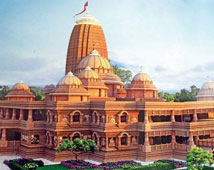
Puri is the holiest place in Orissa and one of the biggest pilgrimage centres in India situated on the shoreline of the Bay of Bengal. Here, the city's activities generally revolve around the Jagannath Temple where devotees visit from far and near. The town is divided into two - the old town the main residential area, including the main shops and huge market area. Most nights, the beaches host colorful markets and the city is abuzz with life.
Puri is washed by the sea, and embraced by causarina - fringed beaches. It is said that one obtains 'moksha' from the cycle of birth and rebirth, if one stays here for three days and nights. Puri is the hallowed seat of Lord Jagannath (Lord of the Universe), Subhadra and Balabhadra. One of the four holy dhams of Hinduism, Puri is possibly one of the very few religious sites which combines the outdoor pleasures of sea and divine beaches with the religious sentiments of 'darshan'.
A place, known by many names over the centuries - Nilgiri, Niladri, Nilachal, Purushottam, Sankhakshetra, Srikshetra, Jagannath Dham, Jagannath Puri - Puri is dominated by two great forces, one created by God, and the other by man.
Puri has the Bay of Bengal and the rice-growing alluvial plain on its east, Khurda district on its west, Sambalpur on its south and the state capital Bhubaneshwar on its northern side. The forest area lying to the west of Puri provides bamboo and sal. The district of Puri encompasses most of the Chilka Lake, Asia's largest freshwater lake. Bhubaneshwar is also located in Puri district.
The holy city of Puri is located 60-km from Bhubaneswar on the coast of the Bay of Bengal. It is one of the four holy dhamas of India - Puri, Dwarka, Rameswaram and Badrinath Sri Ramanuja visited Puri between 1107 and 1117 century AD and stayed for some time. Vishnu Swami visited Puri in the second half of the 12th century and established a 'Matha' near 'Markandeswar' Tank, called "Vishnuswami Matha". Nimbarka Acharya also made a pilgrimage to Puri, and Srila Prabhupada visited in January 1977. The present temple structure was built in the 12th century by the 'Ganga' King 'Choda Ganga Deva', replacing an earlier structure, which probably dated to the 10th century.
Until recently, almost the entire temple was covered in white plaster, so much so that European sailors in previous centuries used it as a navigation point, referring to it as the "White Pagoda"

Puri Jagannath Temple
The temple of Lord Jagannath ('Lord of the Universe') at Puri is one of the most sacred pilgrimage spots in India, one of the four abodes (dhamas) of the divine that lie on the four directions of the compass. The present temple structure was built in the twelfth century by the Ganga king, Chodagangadeva, replacing an earlier structure which probably dated to the tenth century.
Gundicha Mandir (Temple)
This temple is located at the end of Grad road (the main road) about 3-km northeast of the Jagannatha temple . At the time of the 'Ratha-Yatra' festival , Lord Jagannatha goes to the Gundicha temple and stays there for one week. After one week He returns to His original temple. It is said that the wife of 'Indradyumna', the king who originally established the temple of Jagannatha, was known as "Gundicha". The cleansing of the Gundicha temple takes place the day before the Ratha-Yatra festival as mentioned in "Chaitanya-Caritamrita".
Satyabadi (Sakshigopal)
The shrine of Lord Sakshigopal is only 20 kms away from Puri. the sacred feet of Shri Radha can however be only seen on 'Anala nawami' day.